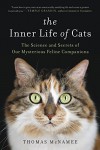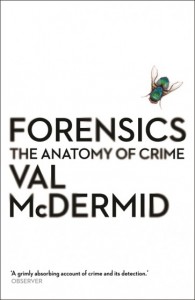Currently Reading






Find me elsewhere:
Investigative Journalism and True Crime Writing Masquerading as Science

I had long rants going through my head on pretty much every page of this book while I was reading, but bottom line, it just doesn't deserve the attention of my detailing them. I like McDermid's crime fiction (most of it, anyway) and I'd very much wish she'd stick to that in the future. There is enough writing "for the effect", garnished with sweeping (moreover: repeatedly dead wrong) generalizations about the justice system and legal history in here to last me the next several years at the very least -- and the fact that this is the way she is writing about the one area that I know personally and in-depth only enhances my doubts about her writing concerning the areas with which I am less deeply familiar, and about which I would very much have liked to learn more.
As I said in my one and only status update, this isn't science writing -- not even popular science writing. McDermid lists a number of science books in the bibliography at the end of this book, but there is no indication -- neither in foot- or endnotes nor in any other way -- how, if at all, the contents of those or other books, or other forms of research, personal knowledge and experience actually impacted her writing, are reflected therein, or would provide further information on specific topics that she addresses (by which I don't mean general areas and disciplines such as entomology or toxicology as such but individual aspects of these disciplines that she touches on).
The only thing we may reasonably be assured of is that she talked to a number of scientists and (hopefully) renders the salient contents of their answers with a modicum of faithfulness. Nevertheless, it is their statements she quotes, not her own independent research and knowledge, and obvioiusly, their answers only cover the topics she asked about, leaving plenty of questions both unasked and unanswered. Hence, the actual scientific contents of this book is never more than skin-deep. The vast majority of the book's chapters are a mixture of true crime writing à la Ann Rule and David Wambaugh on the one hand (including lavish, detailed, tabloid-style descriptions of the victims and their suffering), a journalist's description of the physical attributes of her interview partners on the other hand, and a historical and general introduction to the various areas of forensic science that, in any university program, wouldn't merit more than a few minutes' discussion and a recommendation for further reading at home. Mind you, I'm interested in history, so I did enjoy the individual chapters' paragraph-(or-two-)long introductions dealing with the origins of the respective disciplines, but I most certainly could have done without the plethora of lengthy true crime narration and I also didn't need to know what McDermid's interviewees looked like. With very few exceptions, I've learned more about forensic science in law school and by reading forensic accident reports in civil cases and pathologists' statements in criminal cases -- and, more specifically, about forensic anthrophology also by reading Kathy Reich's Tempe Brennan mysteries -- than from this book by Val McDermid.
On more than one occasion, there is not even any indication how McDermid selected her interview partners in the first place (what exactly do the attributes mean that she uses to characterize several of her interviewees in lieu of detailing their professional background, such as "eminent": who awarded these people those attributes, and on what basis precisely?). Indeed, in several instances, there is every reason to believe that these just happen to be people she has come across in her day job as a crime fiction writer. The Professor Bernard Knight she references, for example, is very likely the mystery writer and, according to his own standard short biographical blurb, former Home Office pathologist and professor of forensic medicine who since the early 2000s publishes the Crowner John mystery series and is one of the authors of the "Medieval Murderers" round robins (the first of which appeared in 2005); and the scientists she references from the University of Dundee were involved, last year, in an open university forensics project that used McDermid as a figurehead. That doesn't mean, of course, that these people don't know what they're doing as scientists (in fact, the frequently plodding nature of Knight's fiction writing makes me suspect that he is probably a better scientist than fiction writer, and from what I saw of the Dundee open university project before I had to drop it due to other commitments, it looked both fun and informative) -- but if McDermid's book had the least bit of claim to being a genuine contribution to (if only: popular) science writing, she would openly state her connection with these sources. (As an aside, it is not good journalism, either, not to have done so.)
Final note on the visuals of the specific edition that I read: I was initially pleased because the cover of this edition seemed to promise a relatively matter-of-fact approach without any recourse to showy effects. Unfortunately, that proved to be the case with regard to this particular print edition as little as it is with regard to the book's substantive contents, as the fly making an appearance as the cover's sole illustration also makes an appeareance on the book's every single page, for purely "ornamental" purposes and without the slightest reference to the actual contents of those pages:

 (Scans from the final 2 pages of the chapter on facial reconstruction.)
(Scans from the final 2 pages of the chapter on facial reconstruction.)
Can you possibly get any tackier -- in a book aspiring to a scientific contents, no less?
I read this as the November group read of the Flat Book Society and was planning to use it as my "16 Festive Tasks" book for the "Newtonmas" square: I'm going to leave it on that square provisorially on the basis of the occasional scientific bits contributed by McDermid's interviewees, but will very likely be replacing it by the December rogue Flat Book Society buddy read, The Science of Discworld.









 8
8  12
12 